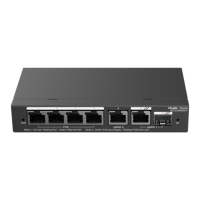Specifies the source IPv6 address or the
source interface. The loopback interface
address(for example: 127.0.0.1) is not
allowed to be the source address.
The ping ipv6 command can be used in the ordinary user mode and
the privileged EXEC mode. In the ordinary mode, only the basic
functions of ping ipv6 are available. In the privileged EXEC mode, in
addition to the basic functions, the extension functions of the ping
ipv6 are also available. For the ordinary functions of ping ipv6, five
packets of 100Byte in length are sent to the specified IP address
within the specified period (2s by default). If response is received, „!‟
is displayed. If no response is received, „.‟ displayed, and the
statistics is displayed at the end. For the extension functions of ping
ipv6, the number, quantity and timeout time of the packets to be sent
can be specified, and the statistics is also displayed in the end. To
use the domain name function, configure the domain name server
firstly. For the concrete configuration, refer to the DNS Configuration
section.
The example below shows the ordinary ping ipv6.
Ruijie# ping ipv6 2000::1
Sending 5, 100-byte ICMP Echoes to 2000::1, timeout is
2 seconds:
< press Ctrl+C to break >
!!!!!
Success rate is 100 percent (5/5), round-trip min/avg/max
= 1/2/10 ms
The example below shows the extension ping ipv6.
Ruijie# ping ipv6 2000::1 length 1500 ntimes 100
timeout 3 data ffff source 192.168.4.10:

